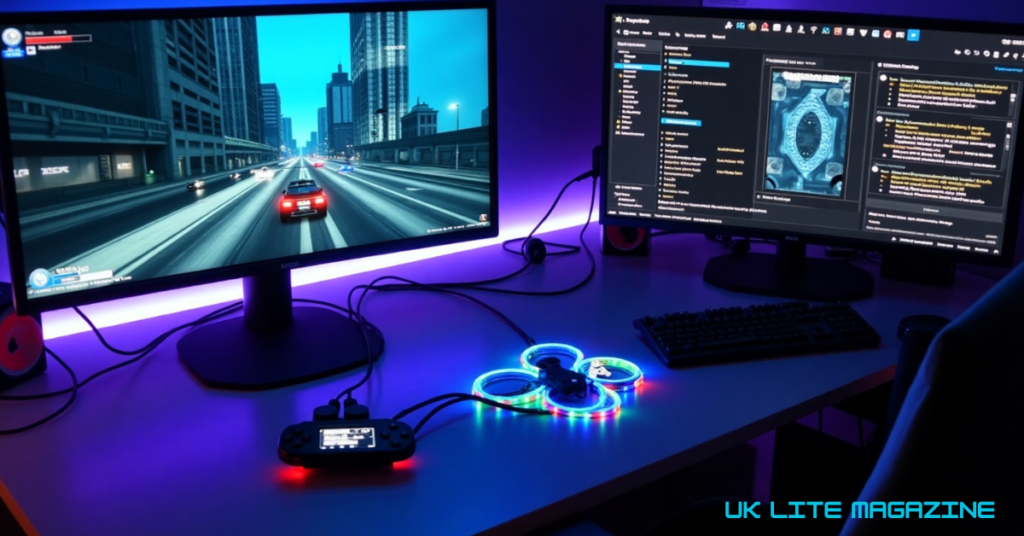Emulating PSP (PlayStation Portable) games on a PC or Raspberry Pi has become increasingly popular, with PPSSPP being one of the most widely used emulators. But to enhance the gaming experience, users are integrating Pico Wiring and HyperHDR, creating an immersive visual setup. This guide will explain what these technologies are, why they matter, and how to set them up correctly.
What is PPSSPP?
PPSSPP is an open-source emulator that allows users to play PSP games on various platforms, including Windows, Android, Linux, and Raspberry Pi. It enhances graphics, supports save states, and offers controller customization.
Features of PPSSPP:
- High-definition resolution support
- Customizable control mapping
- Save and load states
- Texture scaling for improved graphics
- Multiplayer capabilities
What is Pico Wiring?
Pico Wiring refers to connecting and programming the Raspberry Pi Pico, a small microcontroller used for various DIY electronics projects. In the context of HyperHDR, Pico Wiring allows the Raspberry Pi Pico to control LED lighting effects in sync with the gaming visuals, enhancing the overall experience.
Why Use Pico Wiring with PPSSPP?
- Enables LED lighting effects based on gameplay visuals
- Enhances gaming immersion
- Works well with HyperHDR for responsive lighting
What is HyperHDR?
HyperHDR is an advanced open-source ambient lighting software that works with LED strips to create dynamic lighting effects based on screen content. It is an improved version of Hyperion and is commonly used for gaming and media setups.
Key Features of HyperHDR:
- High-performance LED control with low latency
- HDR and SDR content support
- Customizable colors and effects
- Compatible with Raspberry Pi, Arduino, and other microcontrollers
- Works with video streaming and gaming
How to Set Up PPSSPP with Pico Wiring and HyperHDR
Step 1: Install PPSSPP Emulator
- Download the latest PPSSPP version from the official website (https://www.ppsspp.org/).
- Install the emulator on your preferred device (PC, Android, Raspberry Pi, etc.).
- Configure game settings to match your device’s performance capabilities.
Step 2: Set Up Raspberry Pi Pico for Wiring
- Get a Raspberry Pi Pico and an LED strip (WS2812B or similar).
- Connect the LED strip to the Raspberry Pi Pico using appropriate wires:
- Data Pin: Connect to GPIO pin on Pico.
- Power (5V): Connect to the LED strip’s power input.
- Ground (GND): Connect to the LED strip’s ground.
- Install MicroPython or CircuitPython on Raspberry Pi Pico.
- Write a simple script to control the LED lights.
Step 3: Install and Configure HyperHDR
- Download and install HyperHDR from the official repository (https://github.com/awawa-dev/HyperHDR).
- Open HyperHDR on your computer or Raspberry Pi.
- Select the LED hardware type (WS2812B, SK6812, or other supported LEDs).
- Configure the capture device (your display or HDMI capture card).
- Test LED responsiveness using the built-in preview.
Step 4: Integrate PPSSPP with HyperHDR
- Start PPSSPP emulator and load a game.
- Ensure HyperHDR is running in the background.
- Adjust the LED brightness and color settings in HyperHDR to match your preference.
- Play and enjoy an immersive gaming experience with real-time ambient lighting effects!
Troubleshooting Common Issues
Issue 1: LEDs Not Responding to Gameplay
- Ensure the Pico wiring connections are correct.
- Check the HyperHDR settings to confirm the right capture source is selected.
- Restart PPSSPP and HyperHDR after making changes.
Issue 2: LED Colors Are Not Matching the Screen
- Adjust the color calibration settings in HyperHDR.
- Check if LED type and settings match your specific LED model.
Issue 3: Performance Lag in PPSSPP
- Reduce graphic settings in PPSSPP.
- Disable unnecessary background processes.
- Ensure Raspberry Pi or PC hardware is powerful enough.
Conclusion
By integrating PPSSPP with Pico Wiring and HyperHDR, gamers can enjoy a more visually immersive experience. The dynamic LED lighting effects created using Raspberry Pi Pico and HyperHDR sync with in-game actions, making gameplay feel more engaging and futuristic. While setting up may require some technical knowledge, following this guide will help you get started smoothly.
Frequently Asked Questions (FAQs)
1. Can I use any LED strip with HyperHDR?
Not all LED strips are compatible. The best options include WS2812B, SK6812, and APA102 LEDs.
2. Does this setup work on all devices?
PPSSPP runs on various devices, but HyperHDR and Pico Wiring setups are mainly compatible with PCs and Raspberry Pi.
3. Do I need coding skills for this setup?
Basic coding knowledge (Python or MicroPython) is helpful for configuring Raspberry Pi Pico, but pre-written scripts are available online.
4. Can I use this with other emulators?
Yes! HyperHDR works with other emulators like RetroArch, Dolphin, and Cemu, providing similar LED lighting effects.
5. Will this setup increase input lag?
If configured properly, HyperHDR and Pico Wiring introduce minimal to no noticeable input lag.


